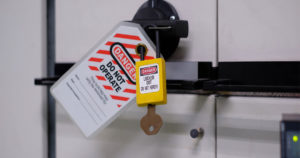Verifying Safeguards at Work to Save Lives
January 16, 2020 Safeguards are used in workplaces to ensure that machine-related hazards are controlled or eliminated. Often, employers are responsible for putting these safeguards into place – but sometimes, employees need to implement or verify them before initiating certain work tasks. According to the Occupational Safety and Health Administration (OSHA), safeguards are essential for protecting workers against needless and preventable injuries.
Safeguards are used in workplaces to ensure that machine-related hazards are controlled or eliminated. Often, employers are responsible for putting these safeguards into place – but sometimes, employees need to implement or verify them before initiating certain work tasks. According to the Occupational Safety and Health Administration (OSHA), safeguards are essential for protecting workers against needless and preventable injuries.
What are Safeguards?
Machine safeguards are safety features installed on or around engineering and manufacturing equipment, which usually consist of shields or other protective devices that cover hazardous areas in order to prevent contact with body parts. Before beginning a job, it is critical to verify that all necessary safeguards are in place. OSHA mandates that safeguards must meet the following standards:
- Prevent physical contact between the machine operator and his or her body from the machine’s “danger zone” during operating cycles,
- Create no new hazards, such as jagged edges or unfinished surfaces,
- Allows for safe lubrication and maintenance of the machine,
- No interference with machine operation, and:
- Be secure and tamper proof in order to prevent employees from bypassing or removing the safeguard
Because employers are legally obligated to provide safe and healthful workplaces, implementing and maintaining safeguards is a requirement. Employers also need to train workers on how to use safeguards and ensure that there is adequate supervision on the floor.
According to the Bureau of Labor Statistics (BLS), approximately 34,000 individuals sustain machine-related injuries in the workplace every year. More than 10,000 of these are serious lacerations and nearly 5,000 result in amputation of a body part. The BLS has also observed a steady increase in the number of machine-related injuries and deaths over the past few years. On average, more than 770 hardworking men and women sustain fatal injuries involving contact with objects and equipment in the workplace annually.
Examples of Machine Safeguards
There are many different kinds of safeguards that can be used for a variety of workplace tasks in order to protect workers from fatal and permanent injuries. Here are just a few examples of safeguards that effectively prevent these avoidable injuries from occurring in the workplace:
- Restraint devices, such as cords that workers wear around their wrists and are secured to fixed anchor points. These are used to prevent operators from reaching the machine’s point of operation,
- Presence-sensing devices. Presence-sensing devices stop machine operation when the sensing field in a certain area is disturbed,
- Presence-sensing mats, which turn off power when weight is applied, and:
- Pullback devices, like cords that are connected to the operator’s wrists and withdraw the hands from the point of operation during use.
If you sustained a workplace injury resulting from your employer’s negligence, you may want to consider filing a workers’ compensation claim. Workers’ compensation is a type of insurance that provides wage replacement and medical benefits to injured employees. To learn more, please contact a representative at our firm directly.
Philadelphia Workers’ Compensation Lawyers at Galfand Berger, LLP Represent Individuals Injured at Work
Galfand Berger has offices located in Philadelphia, Bethlehem, Lancaster, and Reading our attorneys serve clients throughout Pennsylvania and New Jersey. To schedule a consultation, call us at 800-222-8792 or complete our online contact form.
 Google Screened
Google Screened
